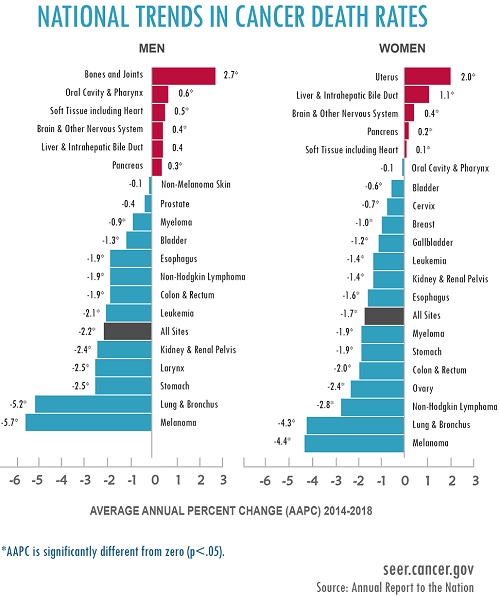Cancer Death Rates Declining in U.S.
Cancer death rates are declining in the United States. That’s according to a new report spearheaded by the American Cancer Society, National Cancer Institute, Centers for Disease Control and Prevention and the North American Association of Central Cancer Registries that measured cancer cases and deaths through 2018. The data show cancer death rates decreased 2.2% per year among males and 1.7% per year among females.
Other key findings:
- Death rates decreased for 11 of the 19 most common cancers among males.
- Death rates decreased for 14 of the 20 most common cancers among females.
- Declines in death rates accelerated for lung cancer and melanoma, slowed for colorectal and female breast cancers, and leveled off for prostate cancer.

“It’s exciting to see cancer death rates continue to decline,” said Dr. Patrick Hwu, president and CEO of Moffitt Cancer Center. “The decrease is tied to innovative research and new targeted therapies and immunotherapies, especially for melanoma and lung cancers. But we have more work to do, including eliminating disparities and fast tracking the timeline from bench to bedside to FDA approval.”
In addition to treatment advances, the report credits smoking cessation efforts for the decline in deaths. However, the authors warned obesity and access to care could threaten any progress that has been made to prevent cancer and improve outcomes for patients.

“For decades, smoking has been the leading risk factor for cancer, but that could easily shift to obesity as smoking rates continue to decline. Excess weight and lack of exercise are bad for your health in general but also increase a person’s risk for developing cancer,” said Hwu.
While death rates slowed in most types of cancer for men and women, there were increases in brain, nervous system and pancreas cancer deaths among both sexes. Also, cancer death rates remain higher among Blacks compared to whites and other races and ethnicities. And when it comes to new cancer cases, oral and throat cancer diagnoses are on the rise in men, and liver and uterine cancers are increasing in women.
It’s also important to note that the data in this report does not include cancer incidence and deaths since the beginning of the COVID-19 pandemic in 2020. Many postponed screenings during lockdown, and experts are concerned there could be an increase in newly diagnosed cancer patients whose disease is at a more advanced stage.



